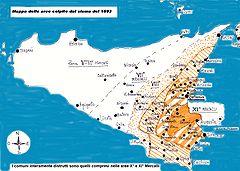
dal 1996 in continua innovazione tecnologica!
Sfrutta tecnologie avanzate per avere un sito web ottimizzato al 100%

The Val di Noto earthquake of 11 January 1693 is, together with the 1908
earthquake, the larger catastrophic event that has struck the eastern
Sicily - in particular the Val di Noto and Vallo di Noto - in historical
times.
With an intensity equal to 7.4 ° of the Richter scale was
by far the most intense earthquake ever recorded in the whole Italian
territory.
The earthquake caused the destruction of over 45
villages, involving effects at or above grade X MCS (Mercalli scale)
surface area of about 5600 km2 and causing a total of 60,000 victims
reaching and in some areas the 'XI degree MCS.
The first strong
shock (about VIII degree MCS) of the seismic sequence that includes this
earthquake came suddenly on the evening of Friday, January 9, 1693 at
about 21. Many buildings collapsed a bit 'all over and there were no
casualties, other buildings were seriously damaged. Since the next day,
Saturday, passed without strong shocks, people had the illusion that all
was over. On Sunday morning, Jan. 11, at 9 o'clock there was a new
strong shock and another about an hour later. But the main event (XI
degree MCS), the terrible and destructive quake of 7.4 Richter °, let
fly at 13:30 causing enormous destruction and the onset of the next
tsunami. The earthquake swarm with the aftershocks, even stronger,
lasted for about 2 years with a large number of replicas (about 1500
events).
Licodia Euboea, part of the remains of the Castle Santapau destroyed by the earthquake of 1693.
The destruction and casualties
The
highest number of fatalities was recorded in the city of Catania which
killed 16,000 people in a population of about 20,000, to Ragusa, where
about 5,000 people have died on 9950, with 4,000 victims in Lentini in
10,000 inhabitants, to Occhiolā (l 'Grammichele old) who had 2,910
people perished and 52% and in Syracuse with about 4,000 victims over
15,339 inhabitants in Militello with some 3,000 victims of a population
of nearly 10,000 Licodia Evia there were 258 registered victims of a
population of about 4,000 inhabitants; the other centers were 15% to 35%
of deaths in the resident population, except Palazzolo Acreide Buscemi
and complained that the disappearance of 41% of population.
Licodia Euboea, the current castle ruins Santapau after the earthquake of 1693.
The current estimates of the earthquake
The
main event features allow you to consider, in many respects, similar to
the earthquake of February 4, 1169, and suggest that the seismogenic
structure is put to sea, not far from the coast between Catania and
Siracusa. An indirect confirmation of this hypothesis is provided by the
tsunami earthquake associated with the event that, again as in 1169,
struck the Ionian coast of Sicily. The hypocentral depth estimated for
the main event is about 20 km. Were recently carried out detailed
investigations to identify the source, the most accepted hypothesis
today is that the system Ibleo-Maltese, also taking into account
evidence of the tsunami.

|
|

|
[ powered by Web Agency Pisa Internet Provider | HOTELS ITALIA | AZIENDE ITALIA | Posizionamento motori di ricerca ]
powered by Network Portali